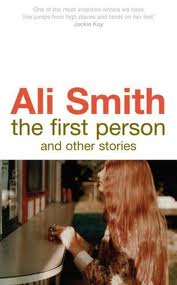
('Goutte de Pluie' © steve lorillere, 2013)
WATERMARKS
by HAYLEY N. JONES
On the surface, Ali Smith’s ‘Writ’ appears to be a quiet, unassuming story: a woman comes home to find her fourteen-year-old self in her house. Their conversation is light and amusing. The narrator wants to confide in the truculent teenager, but can’t bring herself to say any of the important things – how her career turns out well, who to trust, and not to worry about her sexuality. Instead, the narrator warns her fourteen-year-old self about the dangers of coffee, and corrects the girl’s assertion that Keats’ epitaph says: ‘Here lies a poet whose name is written water.’
The story crystallises moments that emphasise the transience of life, as encapsulated by Keats’ actual epitaph – ‘Here lies one whose name is writ in water’ – and, as I read, it became clear that Smith has worked substantial central themes into the narrative: identity, art and immortality.
The narrator and her fourteen-year-old self are the same person, yet they are different characters with discrete identities, raising questions of how frequently our identities change in life. The older identity cannot logically co-exist with the younger, but the two influence each other and are both present in the narrator’s mind. The narrator acknowledges that this fourteen-year-old is part of her: they share memories and personality traits; the narrator would never have become who she is in the present without this teenage girl, despite the differences between them. It is for this very  reason that the narrator cannot forewarn the fourteen-year-old, or even reassure her, about what is to come, despite feeling protective and compassionate towards her: to do so would be to change her own, present identity.
reason that the narrator cannot forewarn the fourteen-year-old, or even reassure her, about what is to come, despite feeling protective and compassionate towards her: to do so would be to change her own, present identity.
‘Writ’ plays with the perspectives of the two main characters, illustrating how events that seem significant become unimportant with the passage of time, and how events that seem insignificant gain meaning when viewed from a different approach. Life becomes a series of such events, their meanings fluctuating and mutating as time passes. The narrator doesn’t remember a boy pushing her over in the snow, yet her fourteen-year-old self is preoccupied with the incident. They both, however, remember their art teacher making them take off their damp clothes to dry on the radiator. The fourteen-year-old dismisses this as an annoyance and calls the teacher a ‘weirdo from weirdoland’. But this is sheer bravado, because the girl then smiles at the memory, and the grown-up narrator knows why: ‘an art teacher I know she’s got a crush on asked her to take off her clothes.’
The impossibility of knowing what her fourteen-year-old self is thinking illuminates the ways in which the narrator has reinterpreted her life, as we all do, editing out some details and highlighting others. Even Keats’ epitaph, carved in stone, is reinterpreted by the fourteen-year-old, who insists that ‘writ’ is not a word, and the phrase ‘written water’ is superior to the original. Keats may be viewed as having achieved a kind of immortality through his poetry, which has long outlived his short life, but, as readers create their own interpretations, all art is fluid in nature.
 Every subtle detail Ali Smith has added to this story reveals another facet of the issues surrounding the central themes – from an acquaintance who kisses the girl ‘against the wall of a builder’s restoration of a row of old shops’, to the common burial ground full of anonymous plague victims outside the window, to a voice of indeterminate gender shouting, ‘I love you’. Everything is pregnant with the possibility of meaningfulness, but it is also liable to be forgotten.
Every subtle detail Ali Smith has added to this story reveals another facet of the issues surrounding the central themes – from an acquaintance who kisses the girl ‘against the wall of a builder’s restoration of a row of old shops’, to the common burial ground full of anonymous plague victims outside the window, to a voice of indeterminate gender shouting, ‘I love you’. Everything is pregnant with the possibility of meaningfulness, but it is also liable to be forgotten.
There is a strong undercurrent to this story. It invites the reader to examine his or her own life, to wonder what we would think if faced with our past selves – and what they would think of us. It reminds us that, sooner or later, we will all exist only as memories, which will, in turn, be forgotten. Compared to the vastness of the universe, even the most exalted human beings are insignificant. Our power to impart meaning diminishes as soon as we express ourselves, since we have no control over how others interpret our words, our thoughts, our art.
However, ‘Writ’ also revels in the ways we enrich our lives – and others’ lives – by creating meaning. The narrator accepts that she cannot reveal her fourteen-year-old self’s future to her because she has to interpret events for herself, to derive her own meanings. To offer a shortcut would not be helpful, even when the unavoidable outcome is good. She acknowledges that it would be ‘somehow terrible even to suggest she’ll go to university’. Instead, the narrator has to meet herself as an equal, not someone with superior knowledge about the future.
As they talk, conflict becomes submerged and the narrator’s thoughts converge with those of the teenager. They are both in the same situation of facing an unknown future. Like the disembodied voice outside – shouting, ‘I love you’ – they have to summon the courage to risk their pride, to risk failure and rejection – to be vulnerable in the hope that their lives will be meaningful and significant, if only to one other person.
~
 Hayley N. Jones has an MA in Creative Writing from the University of Exeter. She won the Devon Prize in this year’s Exeter Writers Short Story Competition and has been previously published in Confingo 2 and on shortstorysunday.com. She blogs about her experiences as a writer with mental illness at hayleynjones.blogspot.co.uk.
Hayley N. Jones has an MA in Creative Writing from the University of Exeter. She won the Devon Prize in this year’s Exeter Writers Short Story Competition and has been previously published in Confingo 2 and on shortstorysunday.com. She blogs about her experiences as a writer with mental illness at hayleynjones.blogspot.co.uk.

